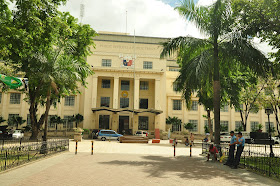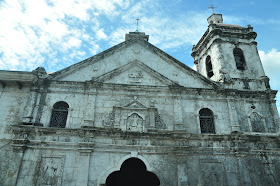I have my own favorite spots in Cebu City, the Queen City of the south. The list includes the Mactan Shrine, The Magellan's Cross and Fort San Pedro. To visit these historical spots, I visited Cebu for the third time since 1993. My last visit was when thousands of troops were consolidated here before their deployment to Sulu during the Sipadan Hostage Crisis in September 2000. Behind me is the statue of Lapu-lapu (Datu Iliji and Kali Pulaku) erected in Mactan Shrine, the first local warrior who repulsed an European invasion in 1521.According to Tausug oral traditions, he was a member of their tribe who settled in Mactan.
The towering statue of Lapu-lapu is facing towards the sea. I can imagine him rallying his people behind him as Ferdinand Magellan and his men disembarked from their boats to attack the village. The natives were outgunned but uncowed. They fought courageously to the last drop of their blood. Legend has it that Lapu-lapu killed Magellan himself in this epic Battle of Mactan. Because of that feat, he is considered as the first ever Filipino warrior.
This area is believed to be the site of the bloody battle on April 27, 1521. During low tide, bigger boats could not make it to the shore as shown in the photo.
This is the marker that shows the short narrative about the Battle of Mactan. Behind it is the painting that depicts the epic battle which showcased the bravery of early Filipinos. Though I bear the name of the invasion force's leader, I am prouder to be identified with our brave Muslim forefather, Kali Pulaku. The Mactan Shrine is only a few kilometers away from Mactan
International Airport. I would suggest that visitors take a cab to visit
this place, though there are several passenger jeeps plying the route
towards this historical place located in Punta Engano.

One of the most important landmarks in Cebu and even the entire Philippines is the Magellan's Cross which is located just across the city hall and a stone's throw away from the Colegio de Santo Nino. According to traditions, this is the site where Magellan planted a cross upon his arrival on April 14, 1521. The Muslim ruler of Limasawa island, Rajah Humabon, and his subjects were converted to Christianity during the first Holy Mass that was celebrated in this place.
When you come inside the tiled pavilion, you will see this ceiling mural that shows the actual planting of the cross by Hernando de Magallanes (Ferdinand Magellan). The original cross gradually deteriorated through the years due to exposure to natural elements. Likewise, some of the religious faithfuls took some parts of the cross, perhaps as religious relics and 'anting-anting' (amulet). It was in 1845 that another cross made of Tindalo wood was erected in the same spot. It is said that the tiny remnants of the original cross were put inside the hollow of this latest cross.
Clad in yellow outfit, these ladies approached me to offer prayer songs to Senior Sto Nino. They said that the prayer songs can be heard and the paying visitor will receive countless blessings from God. They charged me and my buddy P50.00 as they chanted 'Pit Senior' while dancing in front of Magellan's Cross. Though I don't believe their claim, I allowed them to perform the prayers as I took this short video.
The Cebu City Hall is only a stone's throw away from the Magellan's
Cross. It is located in the street named in honor of the Portuguese navigator, Ferdinand Magellan-----Magallanes street. You can see these landmarks around the historical site. The easiest way to visit this place is by taking a cab. It is only about 30 minutes away from the airport.
Entering the Colegio de Santo Nino compound, you will be greeted by this ancient structure called the Basilica Minore del Santo Nino that was constructed in 1566. It is said that this church is built in the same spot where Spanish explorers the wooden image of the Holy Child (Senior Santo Nino) contained in a wooden box that was left behind by Magellan's expedition in 1521. The Spaniards claimed that it survived the fire that gutted down the wooden church that housed, making it a miraculous relic. Learning from their bad experience, the Governor of Cebu directed its major facelift in 1735, using stones and bricks. Pope Paul VI declared its elevated status as a Basilica Minore in 1965. Aside from being a favorite religious destination for Catholic pilgrims, people flock here to appreciate its beauty.
 Not far from the Magellan's cross, you can find Fort San Pedro, a Spanish fort that was constructed by Miguel Lopez de Legaspi in 1565. It began as a single triangular bastion when it was first built
with logs and mud, with Legazpi breaking ground for the structure. During its heyday, it served as the nerve center for
the first Spanish settlement in the Philippines; and, it is considered as the oldest and smallest fort in the country.
It was used to repel sieges by hostile natives and Muslim warriors from the Sulu, Sultanate. It was deemed finished in 1738, about 2 centuries after it
started construction.That was how effective the Moro raids were.
Not far from the Magellan's cross, you can find Fort San Pedro, a Spanish fort that was constructed by Miguel Lopez de Legaspi in 1565. It began as a single triangular bastion when it was first built
with logs and mud, with Legazpi breaking ground for the structure. During its heyday, it served as the nerve center for
the first Spanish settlement in the Philippines; and, it is considered as the oldest and smallest fort in the country.
It was used to repel sieges by hostile natives and Muslim warriors from the Sulu, Sultanate. It was deemed finished in 1738, about 2 centuries after it
started construction.That was how effective the Moro raids were.
It's more fun visiting Cebu!





















thank you sir 4 visitng our beloved place..CEBU
ReplyDelete